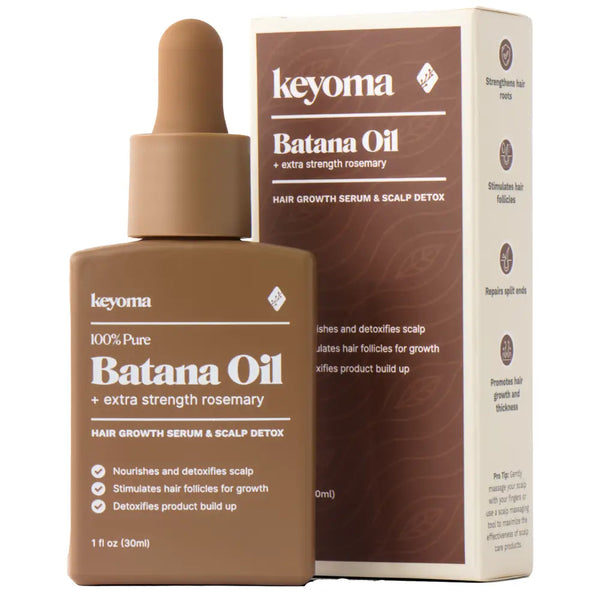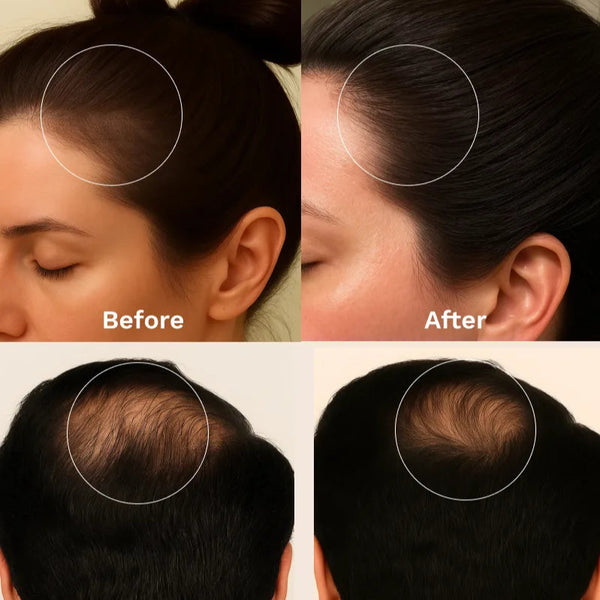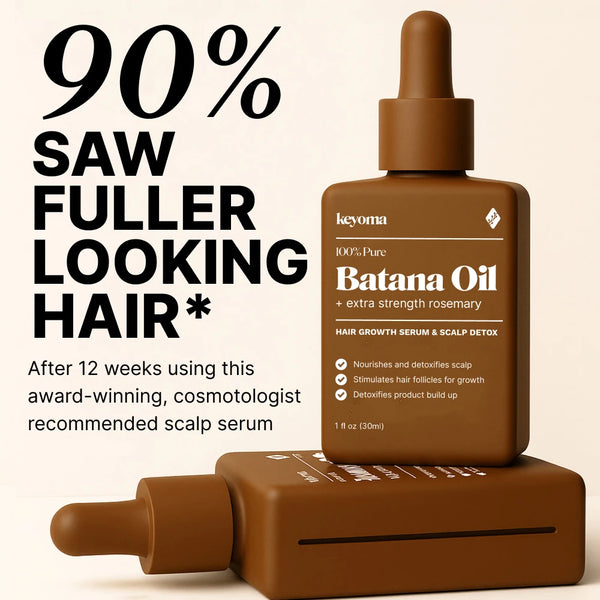In this article
When hair starts shedding suddenly, it can feel scary and frustrating. Maybe you’re seeing more strands in the drain or noticing a new thin spot; either way, unexpected loss can affect confidence and day-to-day well-being.
Below, you’ll find the common causes of sudden shedding, with a look at what might be driving it and practical ideas that could help you address it.
Key Takeaways
-
Sudden hair loss often stems from hormones, thyroid disease, autoimmune conditions, or medication effects.
-
In men, male pattern baldness progresses gradually as DHT shortens the growth phase.
-
Telogen effluvium follows stressors like illness, surgery, high fever, weight loss, or medication changes.
-
Nutrient gaps and triggers like tinea capitis, tight styles, heat, smoking, trichotillomania, eating disorders.
What Causes Sudden Hair Loss in Women
Acute telogen effluvium is the medical term for sudden hair loss in women, and it can be both alarming and stressful. You may see noticeable thinning, which can stem from several issues, including nutrient gaps and hormone shifts.
When shedding shows up, it helps to figure out the root cause so you can choose the most effective treatment for hair loss.

Hormonal Changes
Shifts in hormones can strongly influence hair follicles. During pregnancy, after childbirth, and around menopause, many women notice shedding or changes in density and thickness because levels fluctuate.
Polycystic ovary syndrome (PCOS) is another hormone-driven condition; higher androgen activity can lead to androgenetic alopecia in women, which may worsen hair thinning over time.
Medical Conditions
Health problems such as thyroid disease or autoimmune disorders can disrupt normal follicle function and trigger shedding. Both hypothyroidism and hyperthyroidism are linked with thinning hair.
In autoimmune conditions like alopecia areata, the immune system targets hair follicles by mistake, creating patchy loss. Treating the underlying issue often helps slow or limit further shedding.
Medications and Treatments
Some hormonal birth control pills can contribute to thinning in certain women because they alter hormone balance.
Cancer therapies such as chemotherapy and radiation frequently cause rapid, noticeable loss because they affect fast-dividing cells, which include hair follicles.
Nutritional Deficiencies
Nutrient gaps directly affect hair health because follicles need multiple vitamins and minerals to keep growing normally.
Low iron is a known factor in thinning and loss, and not eating enough protein can weaken strands. Making sure you get zinc, vitamin D, and B vitamins supports growth and may help reduce shedding.
Stress and Trauma
Major physical or emotional stress can interrupt the usual growth cycle and push hairs into a resting stage too soon. This pattern, called telogen effluvium, often shows up as sudden, noticeable loss.
What Causes Sudden Hair Loss in Men?
Seeing clumps of hair in the shower can be unnerving. If that’s you, you’re likely wondering why sudden hair loss happens in men and which causes are temporary.
Whatever the cause, you’re in good company. Hair loss is a frequent concern among men.
Gradual thinning from androgenetic alopecia (male pattern baldness) affects up to half of men by age 50. Since it progresses slowly, you usually have time to notice early signs of balding.
By contrast, rapid shedding develops quickly and usually isn’t caused by male pattern baldness. Read

Male Pattern Baldness
Curious what drives male hair loss? Male pattern baldness or androgenetic alopecia is the most common reason.
This form of hair loss tends to move slowly. You might see a receding hairline first, and months or years later a thinning crown — it usually isn’t the sudden shedding that brought you here.
Genes and hormones both contribute to androgenetic alopecia.
All men produce dihydrotestosterone (DHT), a male steroid hormone. DHT drives male genital development in the fetus and later leads to body hair, facial hair, and a deeper voice.
With age, DHT can also shorten the growth phase of hair. It binds to receptors in follicles, causing miniaturization and gradual thinning that may end in baldness.
Some people inherit more sensitivity to DHT, and that susceptibility can run in families.
Telogen Effluvium
Stress isn’t the same thing as balding, but stress-related shedding does happen.
Telogen effluvium is a frequent cause that’s often triggered by stress, illness, or a major shock. It happens when hairs that normally stay in the growing (anagen) phase shift early into the resting (telogen) phase.
When a large share of your hair pauses growth after a stressor, it can shed at once. That’s why you may notice sudden hair loss with even, diffuse thinning.
Unlike pattern loss, which targets the hairline or crown, telogen effluvium usually involves the whole scalp.
Beyond major stressors like grief or job loss, other triggers include:
-
Illness, serious infection, or a recent surgery
-
High fever
-
Rapid weight loss, especially 20 pounds or more
-
Certain medications, including some beta-blockers and anticoagulants
-
Hormonal issues like an underactive thyroid (hypothyroidism)
-
Autoimmune conditions, especially those involving the thyroid (Hashimoto’s or Graves’)
Although telogen effluvium shedding can begin abruptly, it often appears a few months after the illness or stressful event. But don’t worry, telogen effluvium is temporary and usually improves once the trigger is addressed.
Tinea Capitis (Scalp Ringworm)
Tinea capitis is a fungal infection of the scalp that can make skin red, itchy, dry, and scaly.
Ringworm on the scalp can lead to shedding. When the infection is severe, it may cause a permanent type of hair loss called scarring alopecia, which shows up as distinct bald patches.
Tinea capitis is most common in children and teens, though it can occur at any age. It can also involve the eyebrows and eyelashes.
Because it’s fungal, treatment usually includes an oral antifungal medication plus an antifungal shampoo.
Nutritional Deficiencies
Follicle cells divide rapidly, so growing hair demands a steady energy supply.
If your diet doesn’t provide enough fuel, your body may not prioritize hair growth.
Poor overall intake, or issues like iron deficiency anemia, can contribute to hair falling out.
Vitamin shortfalls that may lead to shedding include:
-
Iron
-
Ferritin
-
Niacin
-
Zinc
-
Fatty acids
-
Selenium
-
Vitamin D
-
Vitamin A
-
Vitamin E
-
Folic acid
-
Amino acids
-
Biotin
Biotin deficiency is uncommon though — most people get enough from a normal diet.
Other Unexpected Reasons for Hair Loss

Hair Loss After Weight-Loss Surgery
Post-surgery shedding is more likely if your zinc stores are low, and it’s common after bariatric procedures. Your clinician may suggest a zinc-and-copper supplement to slow the loss.
Harsh Hair Care Habits
Everyday habits can stress strands and cause breakage or shedding. Over-shampooing, detangling when wet, rubbing with a towel, or brushing too hard or too often can all increase damage. Using a microfiber towel instead of rubbing reduced breakage for me. Two frequent culprits are overly tight braids and heavy weaves that pull on the hair.
Frequent Heat and Chemical Processing
Daily blow-drying, flat ironing, and curling strip moisture and make hair easier to break and shed. Bleach, dye, relaxers, and strong sprays can contribute to the same problem.
Smoking
Your hair isn’t spared from the harm smoking can cause. Toxins in smoke can interfere with follicles and slow growth, making hair more likely to fall.
Trichotillomania (Hair-Pulling Disorder)
Trichotillomania, also called a hair-pulling disorder, is a mental health condition that creates an urge to pull scalp hair. Trichotillomania can be difficult to stop and may lead to bald patches; it can also involve eyelashes or eyebrows.
Eating Disorders
Both anorexia (severely restricting intake) and bulimia (purging after meals) can cause hair to thin or shed because your body isn’t receiving what it needs to grow and maintain healthy strands. These conditions need care from mental health providers, dietitians, and medical specialists.
Sexually Transmitted Infections (STIs)
Some sexually transmitted infections, such as syphilis can lead to patchy loss on the scalp, brows, or face. Treating syphilis with antibiotics usually stops the shedding, and hair commonly regrows.6
Human immunodeficiency virus (HIV) can contribute indirectly. People with HIV have higher risks of iron-deficiency anemia and malnutrition, both of which may lead to loss.22
Spot Triggers, Start Gentle Care, Track With Keyoma
Most shedding ties to fixable triggers like stress, nutrition gaps, hormones, or tight styles. Confirm the cause with a clinician and keep your routine gentle while you treat it.
For an easy upgrade to moisture and slip, try Keyoma’s Pure Batana Oil with Rosemary for simple, nourishing care and everyday scalp comfort. Start now so your next growth cycle does not get delayed.
Featured Product
100% Pure Batana Oil + Rosemary
↓Best Batana Oil to Buy↓
1 Month
Subscribe & Save
- 30-day supply delivered monthly $35
- 30% off for life $6
- Free haircare essentials kit $33
- Free custom wooden comb $10
- Free scalp massager $15
- Free eco-friendly travel bag $8
- 30-Day Money Back Guarantee
- Free Shipping
- Online portal for easy cancel, skip, or pause.
1 Month One Time Purchase

- 30-day supply $50
- 30% off for life $6
- Free haircare essentials kit $33
- Free custom wooden comb $10
- Free scalp massager $15
- Free eco-friendly travel bag $8








